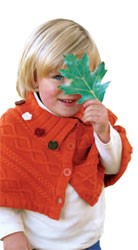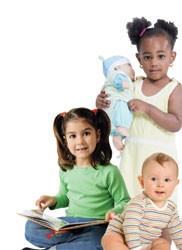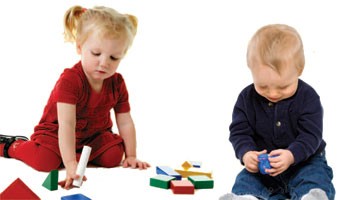Experiencing trust and compassion in relationships
Sarah (15 months) appears anxious during her first days in the infant room. Being in a group with other children is new to her. Jennifer, her educator, holds her, comforts her, and plays next to her with the other children, allowing Sarah to participate at her own pace.
Learning about new environments
On Lee’s (aged three) first day at the centre, the children take him on a tour, pointing out where he can hang his coat, keep his artwork, and wash his hands.
Making connections between experiences
After a walk around town, Jason (4 years) is in the book corner looking at a brochure of the town. “Hey, we saw that on our walk, right Jennifer?” he says to his educator.
Building relationships through group activities
Claire (three years) says, “Let’s have a parade,” and begins to march. Her friends see her and join in. A line of children makes its way through the classroom, and the educator, noticing their excitement, pulls out rhythm instruments, and hands them out as the children march by.
Increasing fine motor skills
Jessica (10 months) sits in her high chair and carefully picks up her Cheerios one at a time.
Testing physical limits
Katie (three years) sits staring at the monkey bars. With great concentration she climbs up the first three rungs, then back down again. “Look Daddy, look! I did it. I climbed up myself,” she says in excitement.
Expressing creative ideas
Brendan (four years) says, “I’m painting the sky green…the frogs are going to invade!” The educator supports Brendan’s idea by responding, “I think green is the right colour for a froggie invasion.”
Distinguishing between real and imaginary worlds
Michael (four years) is playing with a train set. He places a barrier on the tracks, but another child pushes the train through the barrier. “You can’t do that!” says Michael. “You can’t do that on real train tracks. That might cause an accident.” He replaces the barrier.
Recognizing cause and effect
Catherine (three years) is pushing her toy lawn mower across the floor. As she moves more quickly, she sees that its lights start to flash. When she slows her pace, the lights go away. Wanting the lights to come back, she picks up her speed and sees that the lights are back on.




